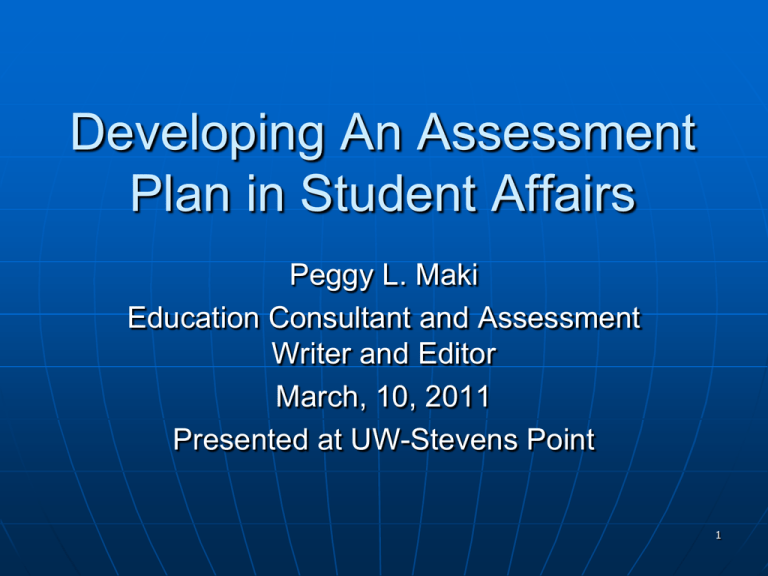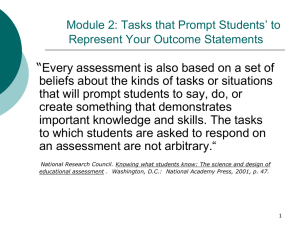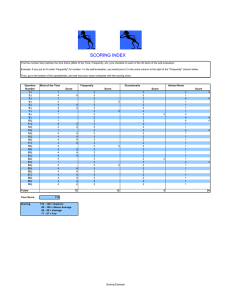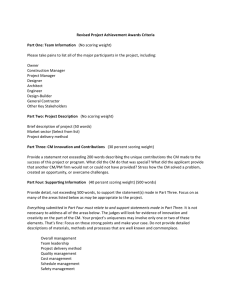Developing An Assessment Plan in Student Affairs
advertisement

Developing An Assessment Plan in Student Affairs Peggy L. Maki Education Consultant and Assessment Writer and Editor March, 10, 2011 Presented at UW-Stevens Point 1 Foci The Big Picture SLOs and Maps Research or Study Questions that Direct the Assessment Process Valid Direct and Indirect Assessment Methods 2 Criteria and Standards of Judgment: What’s Good Enough? Analysis and Interpretation of Results: Soft Times and Neutral Zones Use of Results to Foster Change or Innovation Re-entry into An Assessment Cycle 3 The Big Picture: How Students Learn…. Advising Sports Programs Campus Organizations Study Abroad Technology Internships Learner Service Learning Experiential Learning Work Life Courses Learning Communities Services Res Life 4 What We Are Expecting: Integrated Learning…. Cognitive Psychomotor Affective Expressive 5 Research on Learning Learning is a complex process of interpretation-not a linear process Learners create meaning as opposed to receive meaning Knowledge is socially constructed (importance of peer-to-peer interaction) 6 People learn differently—prefer certain ways of learning (learning inventories: personality, instructional preference, social preferences, visual, global, verbal, sequential, for example) Deep learning occurs over time— transference Meta-cognitive processes are a significant means of reinforcing learning (thinking about one’s thinking) 7 Learning involves creating relationships between short-term and long-term memory Transfer of new knowledge into different contexts is important to deepen understanding 8 How We Position Ourselves to Learn about Our Students’ Learning Positions of Inquiry Institution’s Educators’ Students’ 9 Shared Institutional Mission, Purposes, and Learning Outcome Statements Addressed in Academic Affairs Addressed In Student Affairs Addressed in Other Contributors’ Programs And Services 10 Levels of Learning Outcome Statements Institution-level Outcome Statements (including GE or Core) Department- or Program-level (including GE or Core) Course/Service/Unit /Educational Experience Outcome Statements 11 New UW-SP GE Program Outcomes (abbreviated): Quantitative Skills Critical Thinking Communication Skills: written and oral Broad Knowledge of the Physical, Social, and Cultural Worlds as Well as of The Methods by Which This Knowledge is Produced Responsible Global Citizenship (personal accountability, social equity, and environmental sustainability) 12 Application of Knowledge and Skills, working in interdisciplinary ways to solve problems Wellness (See Appendix A) 13 Which of the new GE Program Outcomes does SA directly contribute to? __________________________________ __________________________________ __________________________________ _________________________________ 14 Maps Help us determine coherence among our educational practices that enables us, in turn, to design appropriate assessment methods Identify gaps in learning opportunities that may account for students’ level of achievement Provide a visual representation of students’ journey 15 Help students make meaning of the journey and hold them accountable for their learning over time Help students develop their own learning map 16 Inventories of Educational Practice Reveal how we translate outcomes into teaching, learning, and assessment practices Occasion discussion about models of teaching and learning (such as Perry), philosophies of teaching, assumptions that underlie teaching and learning Provide a chronological profile of what and how students learn and demonstrate their learning 17 Co-Curricular Map (See Appendix B) Introduce (I) Reinforce (R) Emphasize (E) Multicultural Week Leadership Council Outcome 1: (I) Group Activities involving Interpersonal Communication (I) Community Presentations Speak to different audiences for a range of purposes Greek Life (R) Collaborative Projects with Surrounding Community Outcome 2: Outcome 3: Outcome 4: 18 Identify Methods You Will Use to Derive Inferences about Students’ Achievement of Your Outcome Statements? Tasks that require students to select among possible answers (multiple choice test)? Tasks that require students to construct answers (students’ problem-solving and thinking abilities)? 19 “Every assessment is also based on a set of beliefs about the kinds of tasks or situations that will prompt students to say, do, or create something that demonstrates important knowledge and skills. The tasks to which students are asked to respond on an assessment are not arbitrary. They must be carefully designed to provide evidence that is linked to the cognitive model of learning and to support the kinds of inferences and decisions that will be based on the assessment results.” (NRC) National Research Council. Knowing what students know: The science and design of educational assessment . Washington, D.C.: National Academy Press, 2001, p. 47. 20 When Do You Seek Evidence? Formative—along the way? For example, to ascertain progress or development Summative—at the end? For example, to ascertain mastery level of achievement 21 Direct Methods of Assessment Focus on how students represent or demonstrate their learning (meaning making) Align with students’ learning and assessment experiences Align with curricular-and co-curricular design verified through mapping 22 Standardized Instruments Psychometric approach—historically has valued quantitative methods of interpretation History of validity and reliability Quick and easy adoption and efficient scoring One possible source of evidence of learning 23 Do Not Usually Provide Evidence of strategies, processes, ways of knowing, understanding, and behaving that students draw upon to represent learning Evidence of complex and diverse ways in which humans construct and generate meaning Highly useful results that relate to how you teach or position students to learn 24 Authentic, Performance-based Methods Focus on integrated learning Directly align with students’ learning and previous assessment experiences Provide opportunity for students to generate responses as opposed to selecting responses Provide opportunity for students to reflect on their performance 25 Do Not Provide Immediate reliability and validity (unless there has been or will be a history of use) Usually do not provide easy scoring unless closed-ended questions are used. 26 Some Types of Direct Methods E-Portfolios (can include entries and selfreflection on learning related to involvement in activities) Projects (mid-point and end-point) or culminating projects (solo or team-based) 27 Representative professional practices Agreed upon embedded questions during an activity or at the end of an activity Writing to speaking to visual presentation Team-based or collaborative projects (video-taped?) Case studies (often parallel versions used over time) 28 Internships and service projects Critical incidents Record and analysis of chronological responses to a problem or issue Debates Written responses to a prompt 29 Learning Logs or Journals often maintained online Written proposals Oral presentation of a student or group proposal Critical self-reflective writing (often accompanies student work or occurs after feedback) that documents students’ recognition of what they have learned or what “stumps” them or what they need to do to improve their learning or understanding 30 Problem with solution and ask for other solutions De-construction of a problem or issue Simulations—virtual or live Performance in “immersive or online environments” or scenarios 31 Observations of behavior Expectations about “x” beforehand and comparison after experiencing “x” Externally or internally reviewed internship Video-taping of interaction such as in a meeting 32 Think Aloud Performance on normed instruments that align with your outcomes and educational practices Locally developed instruments Sentence or story completion tests (consider the validity of responses in relation to actual behavior) (http://www.ryerson.ca/~mjoppe/Research Process/841process6bl1c4bf.htm) 33 Performances, productions, creations, projects such as in service learning Visual representations (mind or concept mapping, charting, graphing) 34 Indirect Methods (companion with direct methods) Focus groups (representative of the population) Interviews (representative of the population) Locally designed surveys (representative of the population) Nationally designed surveys 35 Inventories of self-perception, attitudes, values SALG-Student Assessment of Their Learning Gains 36 Other Kinds of Data Student Learning and Development Transcripts (role and skill analysis). See http://www.sandiego.edu/transcript/ sample.php Level of participation in co-curricular programs Other for UW-Stevens Point? 37 Identify Methods to Assess Outcomes Referring to pages 28-38, identify both direct and indirect methods you might use to assess one or more of the new GE Program outcomes that your program aligns with Determine the kinds of inferences you will be able to make based on each method. Identify other institutional data that might be useful when you interpret results, such as judiciary board sanctions or other records 38 Developing Standards and Criteria of Judgment Scoring rubrics--A set of criteria that identifies the: (1) expected characteristics/traits of student work/behavior (2) levels of achievement along those characteristics/traits 39 • Are criterion-referenced, providing a means to assess the multiple dimensions of student learning. • Are collaboratively designed based on how and what students learn (based on curricular-co-curricular coherence) • Are aligned with ways in which students have received feedback (students’ learning histories) 40 Are useful to students, assisting them to improve their work and to understand how their work meets standards (can provide a running record of achievement). Raters use them to derive patterns of student achievement to identify strengths and weaknesses and thus verify the efficacy of educational practices as well as those that need to be changed 41 Interpretation through Scoring Rubrics Criteria descriptors (ways of thinking, knowing or behaving represented in work) Creativity Self-reflection Originality Integration Analysis 42 Criteria descriptors (traits of the performance, work, text) Coherence Accuracy or precision Clarity Structure 43 Performance descriptors (describe how well students execute each criterion or trait along a continuum of score levels). Use numbers or words with descriptive elaboration, such as: • Exemplary—Commendable– Satisfactory- Unsatisfactory • Excellent—Good—Needs Improvement— Unacceptable • Expert—Practitioner—Apprentice— Novice 44 Pilot-test Scoring Rubrics ( See Appendix C) Apply to student work/behaviors to assure you have identified all the dimensions with no overlap Schedule inter-rater reliability times: -independent scoring -comparison of scoring -reconciliation of responses -repeat cycle 45 Meaningful Use of Data: Answering the Question You Raised about Student Learning Collect data from different sources to answer the question you have raised (for example, assessment of graduate student portfolios as well as results of focus group meetings or interviews or surveys). Collect data you believe will be useful to answering the question you have raised. Organize reports around issues, not solely data. 46 Interpretation Establish soft times and neutral zones to interpret collaboratively Seek patterns against criteria and cohorts Tell the story that explains the results based on triangulating evidence and data you have collected Determine what you wish to change, revise, or how you want to innovate 47 Interpret your evidence/data so that your interpretation informs educational practices, budgeting, planning, decision-making, or policies 48 Analyzing, Interpreting, and Acting on Results to Answer Your Research or Study Question Analysis and Presentation of results during a common institutional time through an Assessment Brief • Verbal Summary of findings • Visual Summary of findings 49 Results of Holistic Scoring 70% 61% 60% 50% 40% 30% 20% 20% 11% 10% 8% 0% Emerging Developing Proficient Exemplary 50 Implement Changes and Re-Enter the Assessment Cycle Implement agreed upon changes Re-assess to determine efficacy of changes Focus on collective effort—what we do and how we do it 51 “What and how students learn depends to a major extent on how they think they will be assessed.” John Biggs. Teaching for Quality Learning at University: What The Student Does. Society for Research into Higher Education & Open University Press, 1999, p. 141. 52 Works Cited Biggs, J. 1999. Teaching for Quality Learning at University: What The Student Does. Society for Research into Higher Education & Open University Press Maki, P. (2010). 2nd Ed. Assessing for Learning: Building a Sustainable Commitment Across the Institution. Sterling, VA: Stylus Publishing, LLC. National Research Council. (2001). Knowing What Students Know: The Science and Design of Educational Assessment. Washington, D.C.: National Academy Press. Strayhorn. Terrell, et. als. (2006). Frameworks for Assessing Learning and Development Outcomes. Washington, D.C.: Council for the Advancement of Standards in Higher Education. Sentence Completion Tests or Story Completion Tests. http://www.ryerson.ca/~mjoppe/Research Process/841process6bl1c4bf.htm 53





